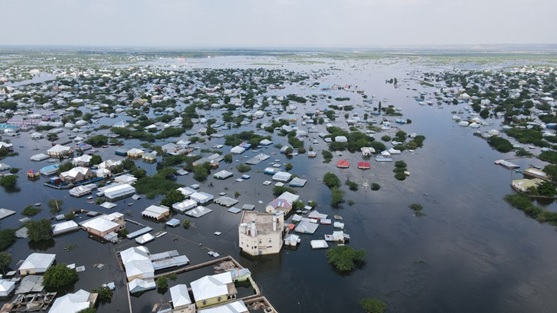By Hussien Mohamed Yusuf
Somalia, a country characterized by its fragile ecosystem and susceptibility to natural disasters, faces a recurring threat from flooding and heavy rains. In recent years, the frequency and intensity of these weather events have escalated, exacerbating the vulnerability of communities reliant on agriculture and pastoralism for their livelihoods. The repercussions of flooding extend far beyond the immediate loss of crops and livestock, permeating every facet of society—from food security and public health to economic stability and social cohesion. In light of these challenges, the imperative of early warning information dissemination emerges as a cornerstone of preparedness efforts against the ravages of nature.

The agricultural sector, which forms the backbone of Somalia’s economy, bears the brunt of flooding and heavy rains. Excessive rainfall inundates farmlands, rendering them unsuitable for cultivation and jeopardizing the livelihoods of millions of smallholder farmers. Crop losses not only disrupt food production but also exacerbate food insecurity in a country already grappling with chronic hunger and malnutrition. Furthermore, the destruction of agricultural infrastructure, such as irrigation systems and storage facilities, compounds the long-term impacts of flooding, hindering the sector’s ability to recover and rebuild. Pastoral communities, deeply entrenched in nomadic traditions, are equally vulnerable to the vagaries of nature.
For centuries, livestock rearing has sustained livelihoods and fostered resilience in the face of adversity. However, flooding poses an existential threat to pastoralists, decimating grazing lands and imperiling the health and well-being of their herds. The loss of livestock not only undermines economic stability but also erodes social and cultural cohesion within these communities. Moreover, the displacement caused by flooding disrupts traditional migration patterns, exacerbating conflicts over scarce resources and exacerbating tensions among competing groups.
Understanding the Threat
Floods and heavy rains pose a dual threat to Somalia’s agricultural and pastoral communities. Excessive rainfall can lead to inundated fields, destroying crops and undermining food security. Moreover, flooding can displace communities, disrupt infrastructure, and contaminate water sources, exacerbating the risk of waterborne diseases.
For pastoralists, flooding can decimate grazing lands, jeopardizing the survival of livestock—their primary source of sustenance and income. In the absence of adequate preparedness measures, these natural disasters can perpetuate cycles of poverty and food insecurity.
The Role of Early Warning Systems
Amidst these challenges, the role of early warning information dissemination becomes increasingly pivotal in mitigating the impacts of flooding and heavy rains. Early warning systems, equipped with meteorological data and hydrological models, can forecast impending disasters with growing accuracy. Timely alerts enable communities to enact preparedness measures, ranging from preemptive evacuations to the reinforcement of infrastructure. However, the effectiveness of early warning systems hinges on their ability to disseminate information swiftly and comprehensively to at-risk populations.
In Somalia, where access to communication channels is limited, and literacy rates are low, bridging the gap between information and action remains a formidable challenge. Addressing these barriers requires a concerted effort from governmental, non-governmental, and community-based organizations to ensure that vulnerable communities receive the support and resources needed to withstand the impacts of flooding and heavy rains. Early warning systems (EWS) play a pivotal role in minimizing the impact of floods and heavy rains.
Challenges in Information Dissemination
Despite the advancements in early warning technologies, Somalia faces significant challenges in disseminating information to vulnerable communities. Limited access to communication channels, low literacy rates, and logistical and security barriers impede the flow of critical information to remote areas. Moreover, the nomadic lifestyle of many pastoralists complicates efforts to reach them with timely warnings. Inadequate infrastructure and institutional capacity further hinder the dissemination process, leaving marginalized communities disproportionately exposed to the impacts of flooding.
Empowering Communities through Information
To enhance the efficacy of early warning information dissemination, a multi-pronged approach is necessary. Community engagement lies at the heart of this strategy, emphasizing the importance of local knowledge and participation. By fostering partnerships between meteorological agencies, humanitarian organizations, and grassroots stakeholders, information dissemination can be tailored to meet the specific needs of diverse communities. Utilizing accessible communication channels, such as radio broadcasts, mobile phone alerts, and community meetings, ensures that warnings reach even the most remote areas.
Furthermore, investing in capacity building initiatives enhances communities’ ability to interpret and respond to early warnings effectively. Training local leaders as first responders equips them with the skills to coordinate evacuation efforts, distribute aid, and provide crucial support during emergencies. Additionally, promoting resilient livelihood strategies, such as drought-resistant crops and diversified income sources, strengthens communities’ adaptive capacity in the face of recurring floods.
In conclusion, the importance of early warning information dissemination cannot be overstated in Somalia’s battle against flooding and heavy rains. By empowering communities with timely and accurate information, we can equip them with the knowledge and resources needed to safeguard their livelihoods against natural disasters. However, addressing the challenges of information dissemination requires a concerted effort from all stakeholders, spanning governmental, non-governmental, and community-based organizations. Together, we can build a more resilient Somalia, where communities are prepared to weather the storms that threaten their prosperity and well-being.
Hussien Mohamed Yusuf
Email:[email protected]
We welcome the submission of all articles for possible publication on WardheerNews.com. WardheerNews will only consider articles sent exclusively. Please email your article today . Opinions expressed in this article are those of the author and do not necessarily reflect the views of WardheerNews.
WardheerNew’s tolerance platform is engaging with diversity of opinion, political ideology and self-expression. Tolerance is a necessary ingredient for creativity and civility.Tolerance fuels tenacity and audacity.
WardheerNews waxay tixgelin gaara siinaysaa maqaaladaha sida gaarka ah loogu soo diro ee aan lagu daabicin goobo kale. Maqaalkani wuxuu ka turjumayaa aragtida Qoraaga loomana fasiran karo tan WardheerNews.
Copyright © 2024 WardheerNews, All rights reserved


